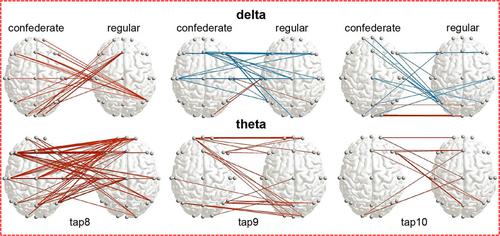当前位置:
X-MOL 学术
›
Ann. N. Y. Acad. Sci.
›
论文详情
Our official English website, www.x-mol.net, welcomes your feedback! (Note: you will need to create a separate account there.)
Dynamics in interbrain synchronization while playing a piano duet
Annals of the New York Academy of Sciences ( IF 5.2 ) Pub Date : 2023-10-12 , DOI: 10.1111/nyas.15072 Anja Lender 1, 2 , Dionysios Perdikis 1, 3 , Walter Gruber 4 , Ulman Lindenberger 1, 5, 6 , Viktor Müller 1
Annals of the New York Academy of Sciences ( IF 5.2 ) Pub Date : 2023-10-12 , DOI: 10.1111/nyas.15072 Anja Lender 1, 2 , Dionysios Perdikis 1, 3 , Walter Gruber 4 , Ulman Lindenberger 1, 5, 6 , Viktor Müller 1
Affiliation

|
Humans interact with each other through actions that are implemented by sensory and motor processes. To investigate the role of interbrain synchronization emerging during interpersonal action coordination, electroencephalography data from 13 pairs of pianists were recorded simultaneously while they performed a duet together. The study aimed to investigate whether interbrain phase couplings can be reduced to similar bottom-up driven processes during synchronous play, or rather represent cognitive top-down control required during periods of higher coordination demands. To induce such periods, one of the musicians acted as a confederate who deliberately desynchronized the play. As intended, on the behavioral level, the perturbation caused a breakdown in the synchronization of the musicians’ play and in its stability across trials. On the brain level, interbrain synchrony, as measured by the interbrain phase coherence (IPC), increased in the delta and theta frequency bands during perturbation as compared to non-perturbed trials. Interestingly, this increase in IPC in the delta band was accompanied by the shift of the phase difference angle from in-phase toward anti-phase synchrony. In conclusion, the current study demonstrates that interbrain synchronization is based on the interpersonal temporal alignment of different brain mechanisms and is not simply reducible to similar sensory or motor responses.
中文翻译:

演奏钢琴二重奏时脑间同步的动态
人类通过感觉和运动过程实施的动作彼此互动。为了研究人际动作协调过程中脑间同步的作用,我们在 13 对钢琴家一起演奏二重奏时同时记录了他们的脑电图数据。该研究旨在调查同步游戏期间脑间相位耦合是否可以简化为类似的自下而上驱动过程,或者更确切地说代表更高协调需求期间所需的认知自上而下控制。为了引发这样的时期,其中一位音乐家扮演了一个同盟者,故意使戏剧不同步。正如预期的那样,在行为层面上,扰动导致音乐家演奏的同步性及其在试验中的稳定性崩溃。在大脑水平上,与非扰动试验相比,扰动期间 delta 和 theta 频段的脑间同步性(通过脑间相位相干性 (IPC) 测量)有所增加。有趣的是,δ 频段 IPC 的增加伴随着相位差角从同相同步向反相同步的转变。总之,当前的研究表明,脑间同步是基于不同大脑机制的人际时间对齐,并且不能简单地简化为类似的感觉或运动反应。
更新日期:2023-10-12
中文翻译:

演奏钢琴二重奏时脑间同步的动态
人类通过感觉和运动过程实施的动作彼此互动。为了研究人际动作协调过程中脑间同步的作用,我们在 13 对钢琴家一起演奏二重奏时同时记录了他们的脑电图数据。该研究旨在调查同步游戏期间脑间相位耦合是否可以简化为类似的自下而上驱动过程,或者更确切地说代表更高协调需求期间所需的认知自上而下控制。为了引发这样的时期,其中一位音乐家扮演了一个同盟者,故意使戏剧不同步。正如预期的那样,在行为层面上,扰动导致音乐家演奏的同步性及其在试验中的稳定性崩溃。在大脑水平上,与非扰动试验相比,扰动期间 delta 和 theta 频段的脑间同步性(通过脑间相位相干性 (IPC) 测量)有所增加。有趣的是,δ 频段 IPC 的增加伴随着相位差角从同相同步向反相同步的转变。总之,当前的研究表明,脑间同步是基于不同大脑机制的人际时间对齐,并且不能简单地简化为类似的感觉或运动反应。



























 京公网安备 11010802027423号
京公网安备 11010802027423号